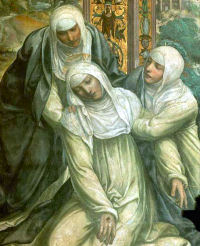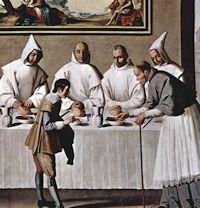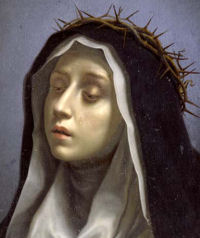Easter: April 29th
Memorial of St. Catherine of Siena, virgin and doctor
Other Commemorations: St. Hugh of Cluny, Abbot (RM) ; Other Titles: St. Catharine of Siena
» Enjoy our Liturgical Seasons series of e-books!
Catherine Benincasa, born in Siena at a date that remains uncertain, was favored with visions from the age of seven. Becoming a tertiary of the Dominican Order, she acquired great influence by her life of prayer and extraordinary mortifications as well as by the spread of her spiritual writings. Her continual appeals for civil peace and reform of the Church make her one of the leading figures of the fourteenth century. Worn out by her mortifications and negotiations she died in Rome on April 29, 1380.
According to the 1962 Missal of Bl. John XXIII the Extraordinary Form of the Roman Rite, St. Catherine's feast is celebrated on April 30 and today is the feast of St. Peter of Verona. He was born about 1205 at Verona. His parents were Manichaeans, but he was converted and entered the Order of Preachers with the ambition not only of preaching the faith but of giving his life for it. He had his wish, for in the course of his apostolic work he was assassinated by the Manichaeans on the road from Como to Milan in 1252.
St. Catherine of Siena

Catherine was a problem, there was no denying it. There was little her parents could do with this youngest of their twenty-five children. She refused to marry and she would not enter a convent. To make matters worse, she insisted on joining the Dominican tertiaries, an organization strictly for married women and widows. She would live like a hermit in a cell, she said, but chose her own cell in her father's home, which sheltered his twenty-four other children, their husbands and wives, and eleven grandchildren.
Catherine continues to be a problem. She is an enigma, a true puzzle, to those who study her life. Few women have had a more amazing career than this young dyer's daughter, who made her way from the bare little room in her parents' home to the palace of the popes at Avignon, who braved revolutionary crowds, wrote letters to cardinals and kings, and all through her life preserved her uninterrupted union with God in times perhaps as unsettled as our own. How Saint Catherine, who has been called by some the "greatest woman in Christendom," who influenced the pope to return to Rome from the "Babylonian Captivity," could have chosen to live exactly as she did is a puzzle to us.
But this was God's will. In a convent she might well have become a saint, but not the kind of saint God wanted her to be. The kind of life she was to lead, her extraordinary influence over popes, kings, sovereign cities, and crowds of disciples, was incompatible with the peace of the cloister. "I have placed you in the midst of your brothers," Christ told her, "so that you can do for them what you cannot do for Me."
What Catherine was, in fact, was a politician. If she had not been a politician, she would have been an entirely different sort of person. The way she bullied two popes would have been inconceivable in our day. Even more astonishing is the fact that the popes listened. They actually paid heed to these not always polite letters from a woman, a woman without learning or position.
God began early to prepare Catherine for her task. She was born in Siena, on March 25, 1347, the daughter of Giacomo Beninicasa and his wife Lapa. Christ first appeared to her when she was only six years old. At seven she took a vow of virginity; at twelve she cut off her shimmering hair to avoid the marriage planned by her parents, and at fifteen e became the first unmarried woman to enter the tertiaries, the Third Order of Saint Dominic. She always got her way. Yet it was not truly Catherine's way; it was God's way for Catherine.
Since her first vision at the age of six, Catherine had belonged completely to God. At first, this was to mean only the happiness of mystical prayer, and visions of Christ and His saints. Later, it was to mean giving herself to Him through the severest suffering. These sufferings took the form of terrible periods of desolation when it seemed to her that God had abandoned her altogether. "Oh Lord, where wert Thou when my soul was in such torment?" she asked our Lord, as He appeared to her after an arduous period of trial. "I was in your heart, fortifying you by My grace"; and He then assured Catherine that from that time He would show Himself to her more often.
It was on Shrove Tuesday, 1366, when all of Siena was celebrating the carnival, that Catherine was espoused to Christ. While she was praying in her room, Christ and our Blessed Lady appeared to her. Taking Catherine's hand, our Lady held it up to her Son, who placed on it a ring that was visible to Catherine but never to other people. It was at this time that Christ told Catherine she was to be of good courage for she was not armed with indomitable faith. Later, Catherine received an invisible stigmata, which became visible after her death, and through which she accepted the physical agonies of the crucifixion.
This spiritual betrothal brought Catherine's years of preparation to an end. She was now ready to go out into the world and carry Christ to others. After becoming a tertiary, Catherine went with the other women to tend the sick (especially choosing those afflicted with the most repulsive diseases), to serve the poor, and to labor for the conversion of sinners. Though always suffering terrible physical pain, living for long intervals with practically no food except the Blessed Sacrament, she was full of practical wisdom and the greatest spiritual insight. Disciples began to gather about her.
She began now to be a problem not only to her family, but to her bishop. Michael de la Bedoyere says of her, "One feels nowadays a person like Catherine, neither nun nor lay-woman, the object of extravagant devotion on the part of local friars, the 'Mamma' of a completely unsupervised group of men and women of all ages, and a self-constituted theologian and spiritual director of all and sundry, clearly the cause of much gossip and criticism, would have caused many sleepless nights to her bishop, and even anxiety to the police."
Nonetheless, the general chapter of Dominicans of Florence gave Catherine its approval and appointed Father Raymond of Capua as her confessor. So numerous were the cases of conscience with which she dealt that three Dominicans were specially charged with hearing the confessions of those who were induced by her to amend their lives.
During the summer of 1370, she experienced a series of visions and heard a divine command to enter the public life of the world. Catherine began correspondence with the princes and republics of Italy, was consulted by papal legates about the affairs of the Church, and set herself to heal the wounds of her native land, which was ravaged by civil war and factions. Above all, she implored the pope, Gregory XI, to leave Avignon. Although she was not able to avert the tumult of civil war, she made such a profound impression on the pope that, in spite of the opposition of the French king and almost the entire Sacred College, he left Avignon and returned to Rome on January 17, 1377. Because of her work in bringing the pope back to the See of Peter, Saint Catherine has been named a patron of Rome.
After helping to bring about peace between the Republic of Florence and the new pope, she returned to Siena, where she passed a few months of comparative quiet dictating her Dialogue, the book of her meditations and revelations.
In the meantime, the Great Schism broke out. In November of 1378, Catherine repaired to Rome, where she supported the cause of the true pope. But this schism could not be solved by politics. Sacrifice was required.
Catherine besought Christ to let her bear the punishment for the sins of the world and to receive the sacrifice of her body for the unity and renovation of the Church. This petition was answered by a vision in which the Bark of Peter was laid upon her shoulders, crushing her with its weight.
After a prolonged and mysterious agony, during which she was paralyzed from the waist downward, Catherine died on April 29, 1380. Through suffering, she had stepped across the threshold into eternal joy. But then, for Catherine, heaven had always been right at the threshold. It was she who had said, "All the way to heaven is heaven because He said, 'I am the Way.'"
—The Lives of the Saints for every day of the year, Vol. 1: January-April
Patronage: against bodily ills; against fire; against illness; against miscarriages; against sexual temptation; against sickness; against temptations; fire prevention; firefighters; nurses; nursing services; people ridiculed for their piety; sick people; Theta Phi Alpha sorority; Europe (declared by Pope John Paul II); Italy; diocese of Allentown, Pennsylvania; diocese of Gamboma, Congo; diocese of Macau, China; Siena, Italy; Varazze, Italy
Symbols and Representation: Cross; heart; lily; ring; stigmata; crown of thorns
Highlights and Things to Do:
- Read St. Catherine's Dialogue.
- Listen to the interview with Dr. Jeffrey Mirus in the Catholic Culture podcasts. He mentions the influence of a biography of St. Catherine.
- Learn more about St. Catherine:
- Catholic Encyclopedia
- Catholic Ireland Part 1 and Part 2
- Saint Stories for All Ages
- Anastpaul
- CatholicSaints.info has many links to e-books and her writings.
- Find quotes from St. Catherine of Siena at the Catholic Reader.
- See her statue in St. Peter's Basilica Colonnade.
- Read 8 Things to Know and Share About St. Catherine of Siena at the National Catholic Register.
- Learn more about the Order of Preachers or Dominicans founded by St. Dominic.
- See Catholic Cuisine for some clever food ideas for this saint.
St. Hugh of Cluny
 St. Hugh was a prince related to the sovereign house of the dukes of Burgundy, and had his education under the tuition of his pious Mother, and under the care of Hugh, Bishop of Auxerre, his great-uncle. From his infancy he was exceedingly given to prayer and meditation, and his life was remarkably innocent and holy.
St. Hugh was a prince related to the sovereign house of the dukes of Burgundy, and had his education under the tuition of his pious Mother, and under the care of Hugh, Bishop of Auxerre, his great-uncle. From his infancy he was exceedingly given to prayer and meditation, and his life was remarkably innocent and holy.
One day, hearing an account of the wonderful sanctity of the monks of Cluny, under St. Odilo, he was so moved that he set out that moment, and going thither, humbly begged the monastic habit. After a rigid novitiate, he made his profession in 1039, being sixteen years old.
His extraordinary virtue, especially his admirable humility, obedience, charity, sweetness, prudence, and zeal, gained him the respect of the whole community; and upon the death of St. Odilo, in 1049, though only twenty-five years old, he succeeded to the government of that great abbey, which he held sixty-two years.
He received to the religious profession Hugh, Duke of Burgundy, and died on the twenty-ninth of April, in 1109, aged eighty-five.
He was canonized twelve years after his death by Pope Calixtus II.
—Excerpted from Lives of the Saints, by Alban Butler, Benziger Bros. ed. 1894
Patronage: against fever
Highlights and Things to Do:
- Read more about St. Hugh:






